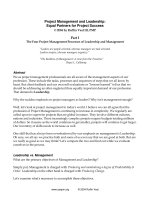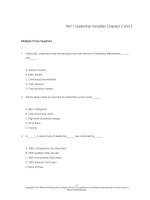Lecture Art of Leadership and Motivation - Lecture 16
Bạn đang xem bản rút gọn của tài liệu. Xem và tải ngay bản đầy đủ của tài liệu tại đây (817.45 KB, 29 trang )
Art of Leadership & Motivation
HRM – 760
Lecture 16
FACILITATOR
Prof. Dr. Mohammad Majid Mahmood
Management in
OrganizationsII
What we know….
Conflict is a naturally occurring phenomenon for
human beings
People do not get involved in conflict situations
unless they have some stake in the relationship or
outcome or both
What we know….
One can never truly resolve conflict, one can only
manage conflict
The costs of unmanaged conflict can be high, but
the gains from using differences creatively can also
be great
Conflict can either be productive or destructive
Why & how do we get in
conflict situations?
Why Conflict Arise?
People differ… so they:
See things differently
Want different things
Have different thinking styles, which prompts them to disagree
Are predisposed to disagree
Have different personalities
Have different status
Have different goals
Are influenced by fear, force, fairness or funds
THE ISSUES
The Facts: present situation, problems
The Goals: how things ought to be, the future conditions
sought
The Methods: the best, the easiest, the quickest, the most
ethical
The Values: the beliefs about priorities that should be
observed in choosing goals & methods
The History: what has gone on before
Theories of Conflict
Traditional Theory
conflicts are caused by trouble-makers
conflicts are bad
conflicts should be avoided
Modern Theory
conflicts are expected between human beings
conflicts are often beneficial
conflicts are the natural result of change
conflicts can and should be managed
Types of Conflict
Differences in Style.
– People's style for a completing job can differ.
– e.g. one person may just want to get the work done quickly (task
oriented), while another is more concerned about having it done a
particular way e.g. artistic
Differences in Background/Gender
– Conflicts can arise between people because of differences in
educational backgrounds, personal experiences, gender and political
preferences.
Differences in Personality
– This type of conflict is often fueled by emotion and perceptions
about somebody else's motives and character.
– e.g. a team leader jumps on someone for being late because he
perceives the team member as being lazy. The team member sees the
team leader as being irrational.
Types of Conflict
Interdependence Conflicts
– A person's job depends on someone else's cooperation, output or
input.
– E.g., a salesperson is constantly late inputting the monthly sales
figures which causes the accountant to be late with her reports.
Differences in Leadership
– Leaders have different styles. Employees who change from one
supervisor to another can become confused
– E.g.. one leader may be more open and delegates responsibility
while another may be more directive. For an employee, it becomes
a conflict situation.
Resolving Conflicts
1. Step One: Set the Scene
• Understand the situation rationally
1. Step Two: Gather Information
• Understand each others needs and concerns
1. Step Three: Agree to a Problem
• Define a mutual Problem
1. Step Four: Brainstorm Possible Solutions
• Think of all the possible solutions
1. Step Five: Negotiate a Solution
• Come to solution that is agreed by both the groups
If the situation remains a conflict, then consider seeking a
third party to mediate.
More Techniques…
1. Recognize conflict is a
process to be managed,
not avoided or
eliminated.
2. Conflict is a problem to
be solved, not a battle to
be won.
3. Stay focused on the
problem or issue to be
solved.
More Techniques…
4.
5.
6.
7.
Ask OpenEnded Questions.
Listen Actively
Keep emotions in control.
Separate People from the
Problem.
8. Focus on Interests, Not
Positions.
9. Use Ground Rules
Conflict Styles
R
E
L
A
T
I
O
N
S
H
I
P
High Importance
3
5
4
2
1
High
Importance
Low Importance
GOALS
Conflict Styles
R
E
L
A
T
I
O
N
S
H
I
P
High Importance
3
5
4
2
1Turtle
High
Importance
Low Importance
GOALS
Turtle - Withdrawing
Avoid conflict at all costs
Give up their personal goals & relationships
Believe it is hopeless to try to resolve conflict
Feel helpless
Easier to withdraw than face conflict
Conflict Styles
R
E
L
A
T
I
O
N
S
H
I
P
High Importance
3
5
4
2Shark
1
High
Importance
Low Importance
GOALS
Shark - Forcing
Try to overpower opponents by forcing them to
accept their solutions
Not concerned with needs of others
Do not care about how others perceive them
Believe in winning and losing
Winning gives them a sense of pride
Try to win by attacking, & threatening others
Conflict Styles
R
E
L
A
T
I
O
N
S
H
I
P
High Importance
3Teddy Bear
5
4
2
1
High
Importance
Low Importance
GOALS
Teddy Bear--Smoothing
Relationships most important, goals of little
importance
Want to be accepted and liked by other people
Believe conflict should be avoided in favour of
harmony
Fearful that conflict will hurt someone
Conflict Styles
R
E
L
A
T
I
O
N
S
H
I
P
High Importance
3
5
4Fox
2
1
High
Importance
Low Importance
GOALS
Fox--Compromising
Moderately concerned with relationships
and goals
Willing to sacrifice part of their goals and
relationships in order to find agreement for
the common good
Conflict Styles
R
E
L
A
T
I
O
N
S
H
I
P
High Importance
3
5Owl
4
2
1
High
Importance
Low Importance
GOALS
Owl--Collaborating
Value goals and relationships
View conflicts as problems to be solved
See conflicts as improving relationships by
reducing tension
Seek solutions that satisfy both parties
Not satisfied until solution is found and
tension is reduced
Which style is better?









